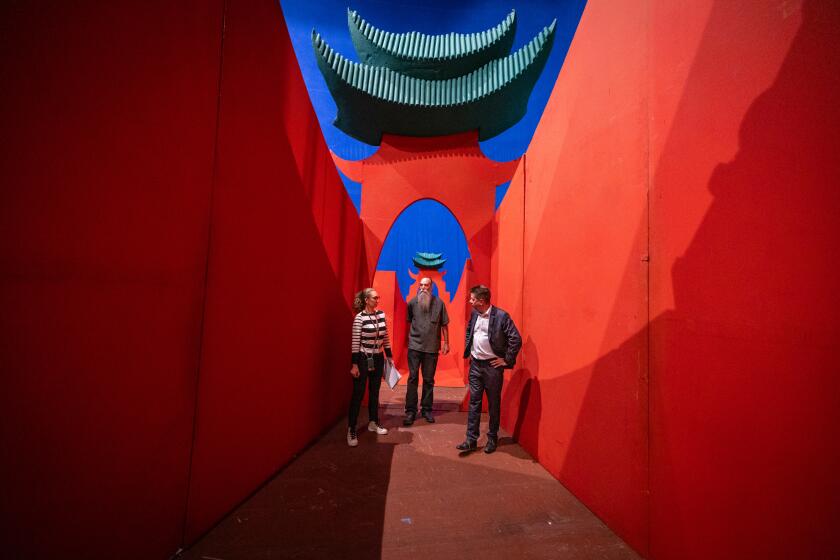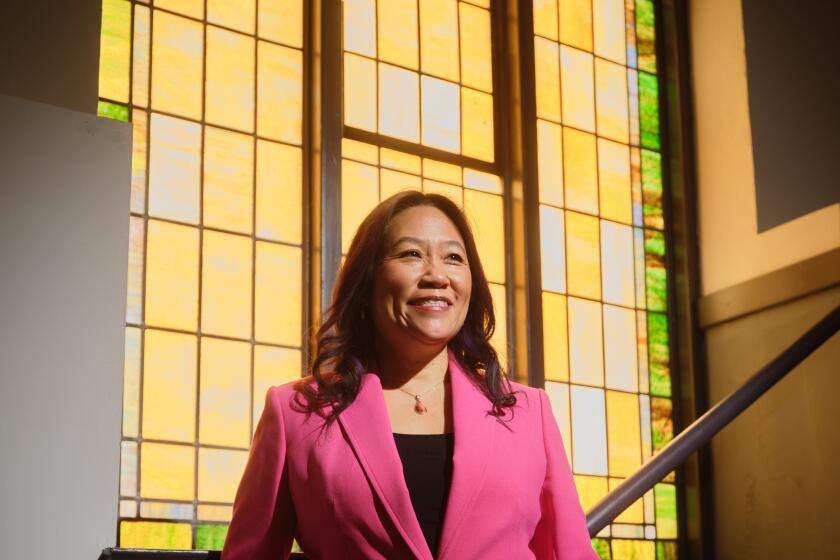Show Redefines Decoration as Frame of Mind
A recollection from the salad days of installation art: “At the beginning of the nineties, a war cry rang from one studio to another: ‘Away with easel-pictures! Away with that unnecessary piece of furniture!’ Painting was to come into the service of all the arts, and not be an end in itself.” The author is art world insider Jan Verkade, remembering a crucial turning point in the history of radical practice--from the 1890s.
The hip insistence that there’s more to art than crafting framed commodities, and that any serious work needs to wrap itself around a viewer firmly located in one specific place and time, turns out to be less novel than most of us imagined. It was a central premise of new art fully 100 years ago. A gorgeous, groundbreaking show at the Metropolitan Museum of Art, saddled with the laborious title, “Beyond the Easel: Decorative Painting by Bonnard, Vuillard, Denis, and Roussel, 1890-1930,” lets us in on this vital early moment in avant-garde ideas and art, and reminds us that they still have leverage today.
Curated by Gloria Groom of the Art Institute of Chicago and the Met’s Rebecca Rabinow, the exhibition presents more than 80 pieces by neglected figures from the dawn of Modernism. The exhibition shows us how keen these artists were to bring their radical images out of the studio and down off the easel, so that they could thoroughly reshape their patrons’ day-to-day existence.
The four artists of the exhibition’s title, like the larger circle they moved in, made paintings custom-ordered to fill specific spots on patrons’ walls; they made suites of paintings conceived as mural decorations, only awaiting walls to hang them on; they made ornamental screens; they designed for furniture and ceramics.
They even drew up stained-glass designs for Louis Comfort Tiffany. (None of the glass itself is in the show, though the original drawings make you wish it were.) “Decoration” was the watchword, with nothing like the sense it has today. It wasn’t that these artists wanted to make pretty pictures to complement a comfy setting. They wanted to rethink what prettiness could be, then fertilize--or infect--the entire bourgeois world around them with their new inventions, into every nook and cranny. They were not like contemporary hacks who do up landscapes in this season’s pleasant sofa colors who manage to convince a few collectors that it’s worth the work to learn to live with what they make.
Most art lovers have some vague idea of Pierre Bonnard’s work, have probably come across an Edouard Vuillard or two, and may know the names at least of their close colleagues Maurice Denis and Ker Xavier Roussel. Maybe they’ll know that Bonnard made his first mark in the fading years of the Impressionists, with pretty pictures in somewhat stronger colors than Monet’s or Renoir’s, favoring more cryptic scenes of moms with kids. Likewise for Vuillard, though with still odder colors and more unsettled subjects: It’s hard to forget the almost simian faces he gave the ladies frequenting his dressmaker-mother’s rooms. But too few people realize that these artists and their colleagues were briefly at the forefront of the escape from realistic representation, and from the grand European tradition, that we are still working through a century later.
They came together into an informal brotherhood in 1888, calling themselves the Nabis--borrowed from the Hebrew word for “prophet”--and they both foretold what was on its way and, in classic prophet mode, never quite got credit for it.
“It is well to remember that a picture, before being a battle horse, a nude woman, or some anecdote, is essentially a plane surface covered with colors assembled in a certain order”--this famous early trumpet call for Modernist radicalism was sounded in 1890 by Denis, the most eloquent spokesman for the group as well as its least talented artist. It’s wrong to read Denis as advocating abstract art itself--content may come after form, but it’s still there. He makes it clear how much the planes and colors of those “nudes” and “anecdotes” meant to the Nabis. Form was no longer just a means to an end, as the latest in a long line of ways of picturing the world, but a separable part of what a painting was about, and worth independent contemplation.
Vuillard, in particular, used striking colors and a novel range of brush techniques that spoke more strongly for themselves than what was seen before him. His exquisite “Album,” a decorative program of five paintings that he undertook in 1895 for the eccentric loft apartment of Thadee and Misia Natanson, his most devoted patrons, shimmers with a huge variety of brush marks.
In the exhibition’s catalogue, an essay by scholar Nicholas Watkins explains how in France, in the later 19th century, public mural paintings (called decorations in French) got a boost in status that made them count for more than the portable, framed works favored by the art market. The official decors of the Third Republic were supposed to embody the public values of the larger community that would come to look at them, and so had special standing among art commissions.
The Nabis, you could argue, were happy to accept the prestige that decoration had acquired--sometimes they even competed to make public art, and lost. (One of the few memorable Roussels in the Met show is his failed submission for a town hall’s walls, showing nothing more heroic than some women standing in a park: Like the Vuillards it resembles, it has fractured surfaces, and disjointed meanings, which must have gotten it tossed out right away.)
But mostly, the Nabis wanted to co-opt the idea and prestige of public decoration, and apply it in the intimate, bourgeois realm where they and their art were most at home. They would assert that the values and experiences that mattered now were private ones, set in the homes that gave their patrons refuge from an uncertain public sphere. (Many of the Nabis’ patrons were wealthy Jews in an age of ethnic nationalism and anti-Semitism.)
The ideal subject for an ambitious brush was no longer great deeds, ideas, and people from the past. It wasn’t even the novel facts of modern outdoor life, such as the Impressionists had often treated. For the Nabis avant-garde, the truly heroic subject was domestic experience, and the very private property that it took place around. They could illustrate and celebrate that experience, even as they radically transformed the settings and objects that helped to give it shape.
More to Read
The biggest entertainment stories
Get our big stories about Hollywood, film, television, music, arts, culture and more right in your inbox as soon as they publish.
You may occasionally receive promotional content from the Los Angeles Times.






